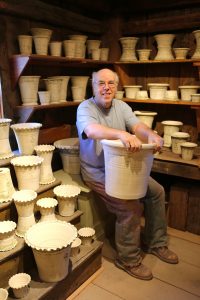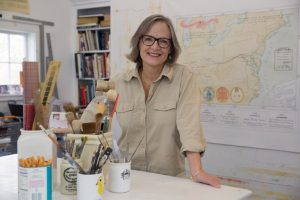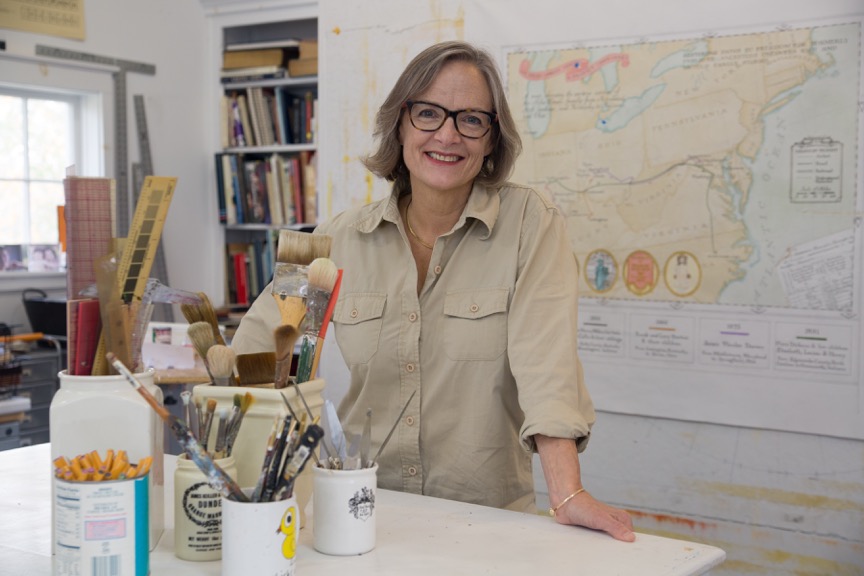
Litchfield County potter Guy Wolff, whose handmade clay pots can be found in the gardens of historic estates (including Monticello and the White House), museums (like the Isabella Stewart Gardner Museum and the Met Cloisters), and suburban backyards across the country, draws inspiration for his creations from both master potters in Europe and traditional American craftsmen.
He says his signature white pots, for example, harken back to Regency England, featuring architectural details like the dentils that are found in the ornamental plaster ceilings of the great English houses of that period.
“I’m mostly thinking of Jane Austen when I’m making them,” he says. “Everything I do goes back to stories about people.” All three of the businesses profiled here are inspired by people’s stories: Redstone Studios, which produces one-of-a-kind maps depicting the stories of people’s lives; The Storyteller’s Cottage, a new literary destination in Simsbury that celebrates books, writers, and readers; and Guy Wolff Pottery, whose pots pay homage to handmade traditionalism, the masters under whom Wolff studied his trade, and history.
The imaginative Connecticut entrepreneurs behind these ventures turned their love for the arts into unique businesses that celebrate creativity.

Connie Brown, Redstone Studios, Durham
Artist Connie Brown says it was an epiphany she had while on a summit in the Spanish Pyrenees that ultimately led to the creation of Redstone Studios, her custom map-making business. “I got to the top and the thought I had was: ‘I’m going to make a map of this hiking trip when I get home,’ ” she recalls.
Brown had her guide mark the path they had taken on government maps she had collected while traveling. “I knew nothing about putting maps together, but I somehow reconciled the different scales of the maps,” says Brown, who used the project as “a stalling technique” while applying for English teaching jobs.
“I thought, ‘Hey, maybe if I learn a little more, I can make one-of-a-kind travel maps for people who love to travel.’ ”Brown’s Durham-based business has evolved into so much more: Her beautiful, hand-painted creations – many of which are modeled after maps from the 17th century (the “golden age of cartography,” according to Brown) – not only immortalize clients’ travels, they document their ancestry and literally map out their lives. Brown has created maps that celebrate treks, bike trips, honeymoons and international adoption odysseys, as well as life histories and family migrations.
Her maps depict beloved destinations, alma maters, historic districts, environmental regions, and favorite fishing waters. Her most recent project tracks the journey of a client’s ancestors – who were slaves – along the Underground Railroad to freedom.
Another map, hanging on a wall in her studio, plots the geographical origin of every known translation of Alice in Wonderland. The former incorporates a trompe l’oeil rendering of the first U.S. Census to include African Americans (the client’s relatives’ names are among those listed).
The latter features drawings of characters from the famed Lewis Carroll novel and was actually printed on the endpapers for a series of scholarly tomes about Alice in Wonderland translations around the globe.
One of Brown’s works even hung above former Vice President Dick Cheney’s desk in the West Wing of the White House during his tenure: That five-and-a-half-foot-long canvas, commissioned by Cheney’s daughters to commemorate their father’s sixtieth birthday, documented the route Cheney’s great-grandfather, Captain Samuel Fletcher Cheney, took during the Civil War, and was created in collaboration with Brown’s then-partner, painter Julie Ruff. Today, Redstone Studios is mostly a one-woman operation, though Brown occasionally gets help from her architect husband, Duncan Milne, who designed her studio on their 1843 property (formerly Durham Academy).
She also works with art printer Mike Suozzi to produce museum-quality prints of her original maps. Brown, who has travelled across the country to visit properties she is mapping, and has even been known to bring back artifacts – like red clay from a ranch in Texas or a turkey feather and fly-fishing lures from a fishing camp near Asheville, North Carolina – to incorporate into her maps, says she spends an average of 200 hours on each project.
And she charges accordingly: Her maps, which are typically painted onto 3×4 canvases, start at $10,000 (though she occasionally makes smaller ones starting at $5,000). “Sometimes, there are people who do have everything,” she says. “Except this.” Brown never formerly studied art or cartography, but she does have a degree in English, which she claims is not irrelevant to her business. “Maps are about communication,” she explains.
Still, Brown says she has always been a “pretty good artist,” and has even done some freelance illustration over the years.
“I was always drawn to scientific art, like botanical and zoological drawings, all the stuff I do now on a regular basis,” she says. “And every now and then, I would actually copy an old map – I just liked doing it.”
Brown admits that she initially spent more time on the decorative aspects of her maps – adding embellishments like compass roses, cartouches and antique lettering, and using a translucent brown wash to impart a vintage feel – than she did on cartography.
But eventually she learned more about the history and science of mapmaking, joined the New York Map Society, and, in her words, “became a total map nerd.”
Today, the map artist, a board member of the New York organization and founder of the recently launched Connecticut Map Society, gives lectures and workshops in the art of cartography.
“I don’t populate my maps with place names and features in the way a general mapmaker would. I’m essentially depicting my client’s world,” she says. “That’s the way people like it. We feel that way from childhood – that we are the center of our worlds.”
Lisa Natcharian, The Storyteller’s Cottage, Simsbury

“I didn’t start this project knowing I was starting this project,” says Lisa Natcharian of The Storyteller’s Cottage, a historic manor house in downtown Simsbury that she has transformed into a unique venue for all things literary.
The “cottage” came with the Fiddler’s Green property that Natcharian and her husband, Matthew Natcharian, bought as an investment in December 2016. Though the Victorian house had been used as an office building, she says,
“I looked at how beautiful all these historic details were and I thought, ‘No, we can do better than that.’ ” Natcharian started making lists of possible uses for the space, and realized that all of her ideas had the same underlying theme – they all related to literature. So the freelance writer, prolific reader, and self-proclaimed “book nerd” decided to create a “hub for people who love literature.”
Home to an assortment of literary societies and themed book clubs, a writing space for local authors, and a setting for writer’s workshops and literary soirées, The Storyteller’s Cottage also features three “mystery rooms,” the book-lover’s version of escape rooms (except instead of trying to find a way out, you try to solve a mystery).
“The Jules Verne Steampunk Library,” for example, the setting for the Detective’s Dinner Party mystery adventure, is chock-full of old, leather-bound books and other vintage artifacts.“I love the immersive aspect,” says Natcharian. “When you do a specific activity in a themed space, it elevates that activity into something special.”
Thus, the Mysterious Pendragon Society, “a private club for young thinkers and creators” who are fans of fantasy fiction, meets in the secret “Medieval Keep,” accessed through a bookshelf in the “Enchanted Library.” And the Great British Baking Club, a book club in which members enjoy recipes inspired by PBS’s The Great British Bake-Off while discussing culinary mystery novels, takes place in the “English Country Kitchen.”Natcharian, who designed the house to make visitors feel like they are stepping into the pages of their favorite novels, had planned on a soft opening in October, but says the response to The Storyteller’s Cottage has been overwhelming, with local authors coming out of the woodwork.
“It’s been crazy,” she says. “People pop in off the street, they call, all kinds of authors want to offer classes and workshops – I can’t believe how many authors there are in this area.”
Authors currently running programs at the cottage include mystery writer Steve Liskow; Lisa Fiedler, author of books for children and young adults; fantasy writer Michael Bertolini; and children’s book author Karin Lefranc.
Other recent and upcoming offerings include a storytelling workshop with Moth StorySLAM champion Terry Wolfisch Cole, a talk about the road to publication given by young adult author Carrie Firestone, and a 6-week course on getting personal essays published by C. Flanagan Flynn, managing editor of Brain, Child and Brain, Teen magazines.
There are creative writing programs and themed book clubs geared to both adults and children. The Storyteller’s Cottage allows Natcharian to be immersed in something she really loves.
“I love the reading, I love the decorating, I love speaking with people who love reading,” she says.
A mother of three who also runs a website for gifted children called Raising Wizards, says it has already been gratifying to watch kids come and connect with one another over their love of books.
At the venue’s recent open house, Avon residents Julie and Greg Wolfe explored the cottage with their eight-year-old son, Connor, who sported a Harry Potter-inspired “Gryffindor” t-shirt. “We are both writers,” says Julie Wolfe. “If we could birth a house, this would be it.” Their son, who eagerly guided other visitors around the Medieval Keep, was equally smitten. Says the young bibliophile: “I want to stay here for the rest of my life.”







More Stories
Skin Deep
Sweet Indulgences
Illuminating the Season